How to build a well: description of installation work
There is always water in the land. Sometimes it is close to the surface, sometimes far, but you can get to it. And if you do this, then you will have an unlimited amount of free drinking water. And this is a high-quality watering of crops, ensuring the work of all the plumbing in your home and satisfying your own drinking needs.
To do this, you need to know how to build a well with your own hands.

In this article we will look at the possible types of wells, the course of the installation and the building materials recommended for them.
General provisions
First you need to decide on what type of well you are going to sell.
Types of wells
- Mine It is a pit with dimensions ranging from seventy centimeters to one and a half meters, which depends, first of all, on the convenience of work in it. Its creation is very laborious, but it allows you to go through hard layers of the soil, up to the moraine and do it yourself with no special skills.
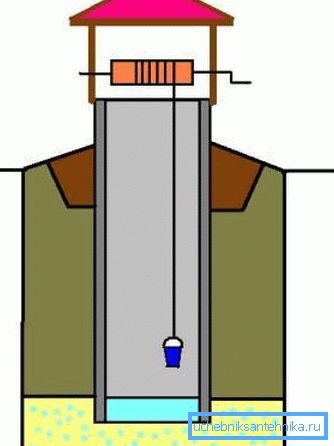
- Tubular. Its width can be generally from five to thirty centimeters, which allows you to get to the deepest H2A. But, firstly, you will need special drilling equipment; you will not get by with shovels alone. Secondly, it will be very problematic to pass stone deposits in case of their presence on the way to the aquifer.
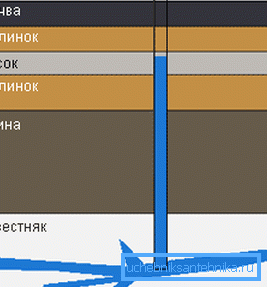
Since the diameter of the mine does not affect the performance in any way, it is guided by the choice of the level of groundwater and the layers of soil lying above them. It is also worth listening to your personal preferences on how to resolve this issue..
You should know: any of the types of wells can be equipped with a manual method of lifting fluid, and automated. Therefore, this criterion should not influence the choice.
Groundwater options
By dredging into the ground one can reach in order of the following deposits of H2ABOUT:
- Verkhovodka. Depth - 1-6 m. This is the uppermost aquifer that we will meet. The water in it has a weak degree of purification due to the small size of the natural filter, and there is a high risk of sewage ingress into it. Its quantity directly depends on the precipitation. It does not have a waterproof layer and therefore can break down at any place to more stable groundwater deposits.
Advice: it is possible to apply such liquid only for watering and irrigation of the vegetable garden, but the installation of a well for this is unprofitable.

- Ground Depth - 10-40 m. This is the formation of the first stable aquifer from the surface. It is he who at the exit to the surface forms springs that are so popular for urban residents. It does not have high pressure and, falling into the well, it fills it up to the same level with the horizon. Also replenished by the surrounding rivers and reservoirs. To reach them will not be difficult on their own without the help of specialists.

- Artesian. The depth is 50-300 m. Such an aquifer is sandwiched between two water-resistant layers, which, firstly, gives it excellent protection against external pollution. Secondly, it makes it pressurized, and the immersion of the mine into it takes place an intensive rise of water to the top. Expensive production, requiring the participation of professionals with appropriate drilling equipment. But the perfect result in the form of a clean source with a big debit.
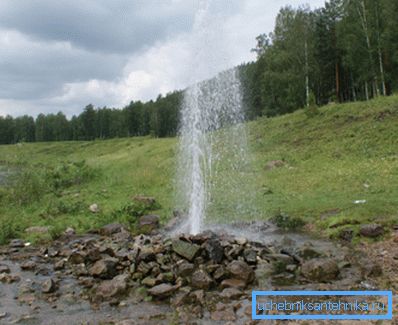
Mine Well Construction
How to build a well? Start by choosing the right place.
Location selection
For this, it is best to look around for the presence of similar structures.
Further, using the aneroid barometer, it will even be possible to determine the depth of the N2About on your site, given that 0.1 mm on its panel is equivalent to 1 m depth:
- We place the device on the ground next to the existing structure. Suppose it shows 621.3 mm.
- We carry it to the chosen place, and if, for example, it demonstrates 621, 9 mm, it will mean that, most likely, you will have to dig 6 meters more.
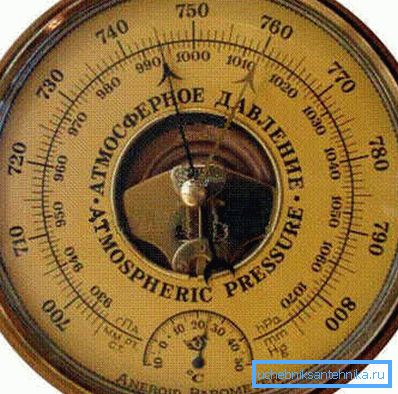
If near your site there are no structures that play the role of water supply, you will have to call in specialists. The most accurate determination of the availability of the required aquifer is exploratory drilling. And even though its price is lower than full-fledged works, it still goes out very expensive.
There are a couple of conditions that must be observed when choosing a suitable site:
- Removal from dung heaps, toilets, garbage dumps, baths and other sources of pollution at 25 m.
- The presence of a flat surface, otherwise on the slope of the groundwater will drain.
Tip: after choosing a place before starting work, be sure to go to the appropriate state authorities and get a building permit. If you do not do this, then a large monetary fine awaits you.
Excavation

The well with respect to the aquifer can be dug in the following ways:
- Imperfect. The mine does not reach the impermeable layer, which allows the fence to be taken both from the bottom and from the sides.
- Perfect. There is an emphasis in a strong lower layer, and then the inflow is carried out only through the walls.
- With sump. In this case, an additional reservoir, a sump, for collecting liquid is dug out in a solid foundation. This leads to a significant increase in debit.
Tip: It is recommended to observe equality between the reserves of the well and the daily consumption of water from it. Because as a result of downtime, the processes of decay will begin.
To carry out high-quality filtration and the inflow of a sufficient amount of fluid on the side walls is a very laborious exercise. And the presence of a sump implies industrial water costs. Therefore, we will focus on the imperfect version, which is ideal for domestic use.
Thus, we dig a square pit with a side of 1.2 m and a depth to the aquifer plus a third of its thickness.
At the bottom we create a bottom filter of the well of three layers of gravel, the first one is 10 cm thick, the rest 15 cm. At the same time, each subsequent one should have a fractionality five times larger than the previous one below.
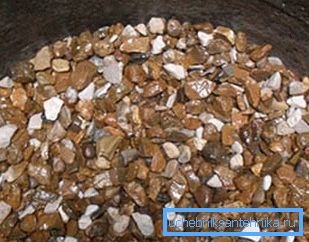
Tip: If the ground is too thin, it is recommended to install the shield and the boards first, and then pour the bottom filter components onto it.
Next is the turn of the walls, for which you can use different materials.
Wooden walls
Let's analyze how to build a well from a timber:
- We prepare oak wood, as it in the best way tolerates a long stay in water and is able to serve like this for up to a hundred years. Above water, however, its service life does not exceed a quarter of a century, therefore, in order to save, it is recommended to use, for example, cheaper pine to create a wellhead.
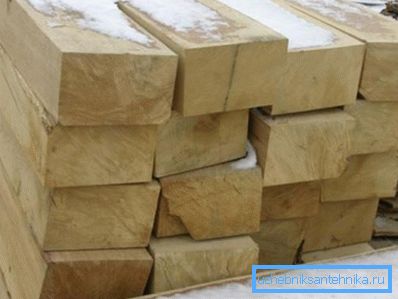
- The design is collected first outside to mark the sequence of each part. The joints are made by the “paw” method, the corners are fixed with steel dowels. The bars are pairwise joined with special brackets for greater reliability of the structure.

- In the mine itself there are different ways of mounting the structure:
- From the bottom of the mine. If the depth of the pit is small, then it is advisable to start immediately from the base. Install the lower crown on top of the bottom filter and build up the rest of the elements.
- Lower mount. If necessary, it is more rational to dig a few meters of a well deeper mine, to assemble part of the frame so that it rises to three crowns above the ground. Then we dive a quarter of a meter and remove the ground from under the lower boards, leaving the corners untouched. We put props and remove the remaining soil. Beat out props.
If the structure does not settle well, then we knock it on top with a hammer. And so we move to the desired depth.
- From above, we draw a cap up to eighty centimeters above the ground and cover it with a roof for a well.
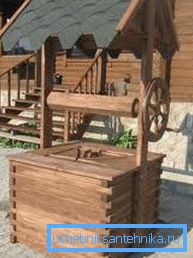
- On the perimeter we lay a clay castle with a depth of one meter and a width of half a meter. Top pour cement screed.
Concrete walls
Concrete benefits in multiple points due to its strength, durability and hygiene.
Instructions for their construction is as follows:
- We install the formwork along the inner perimeter of the mine.

- We make reinforcement with steel corrugated rods. We install vertical products and fasten horizontal ones to them. This will strengthen the concrete.
Tip: fixing fixtures is recommended using soft metal wire. Welding should not be used, since it violates the elasticity of iron.
- Preparing the solution. To do this, mix cement brand M 400, quartz sand and crushed stone in proportions of 1: 2: 3 at water-cement ratio.
- We pour concrete and wait for four weeks to set.
Such a structure can also be installed by the lowering method, increasing it from the outside and gradually undermining the ground.
More convenient to install the construction of concrete rings. Factory samples allow to avoid the time-consuming process of concreting and proceed with the installation immediately. To prevent movement between them, steel braces are laid, and sealing of the joints is carried out with the help of hemp.
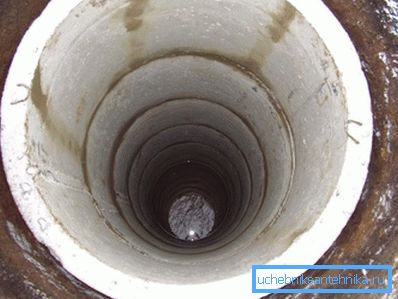
Brick walls

The laying is laid out only from below. When this is used only red dense quality baked products. An ordinary silicate brick will not last long in such aggressive conditions.
The shape of the mine is usually used in such cases round.
Construction of a tubular well
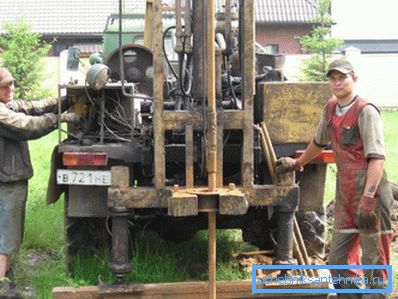
If you are going to drill a well to the artesian aquifer, it is better to contact the specialists for several reasons:
- It is incredibly difficult and long to overcome more than a hundred meters of land by hand.
- When you meet on the path of the hard layers you may not have the right drill. And if you buy everything, it will be too expensive.
- The slightest mistake in the drilling technology can reduce the quality of the produced water.
- Only a drilling company will be able to provide you with a technical passport of your well, which will be necessary to get the right deep well pump.
Attempting to save money and do it yourself will most likely only lead to even greater costs.
Conclusion
If you have your own site, you can always build a quality well on its territory. You can use two options for this: mine, leading to groundwater, or pipe, descending to artesian deposits. Both have their advantages and disadvantages, but mine is much easier to implement with their own hands.
The construction can be made of wood, concrete or brick. The most practical and cost-effective while using concrete rings. It is also important to properly equip the bottom filter, which is responsible for the initial purification of the aquifer.
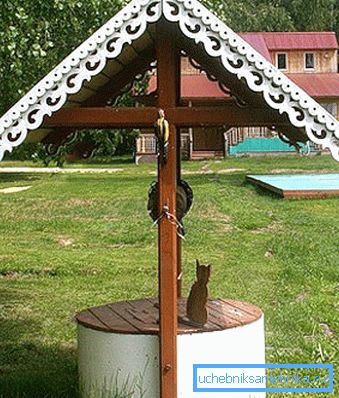
The video in this article will introduce you to additional materials.
Successful to you construction work!